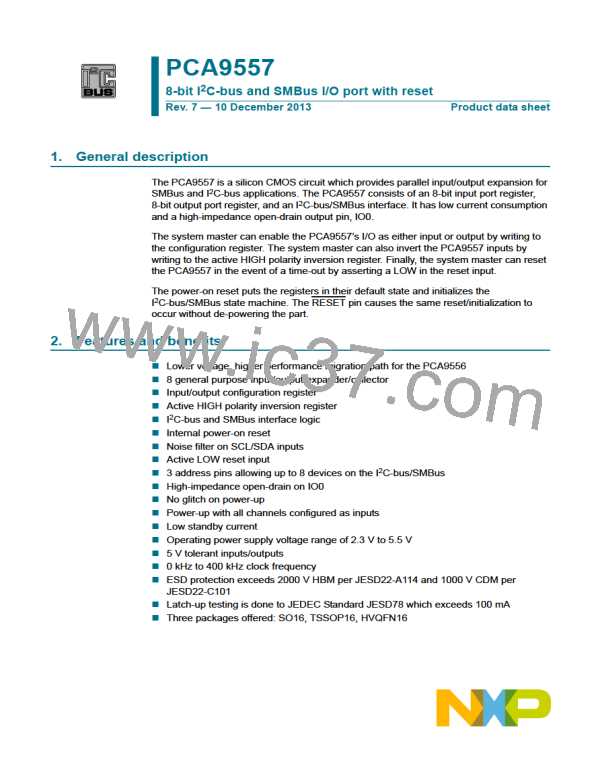PCA9557
NXP Semiconductors
8-bit I2C-bus and SMBus I/O port with reset
SDA
SCL
S
P
STOP condition
START condition
mba608
Fig 11. Definition of START and STOP conditions
8.2 System configuration
A device generating a message is a ‘transmitter’; a device receiving is the ‘receiver’. The
device that controls the message is the ‘master’ and the devices which are controlled by
the master are the ‘slaves’ (see Figure 12).
SDA
SCL
SLAVE
TRANSMITTER/
RECEIVER
MASTER
TRANSMITTER/
RECEIVER
MASTER
TRANSMITTER/
RECEIVER
2
SLAVE
RECEIVER
MASTER
TRANSMITTER
I C-BUS
MULTIPLEXER
SLAVE
002aaa966
Fig 12. System configuration
8.3 Acknowledge
The number of data bytes transferred between the START and the STOP conditions from
transmitter to receiver is not limited. Each byte of eight bits is followed by one
acknowledge bit. The acknowledge bit is a HIGH level put on the bus by the transmitter,
whereas the master generates an extra acknowledge related clock pulse.
A slave receiver which is addressed must generate an acknowledge after the reception of
each byte. Also a master must generate an acknowledge after the reception of each byte
that has been clocked out of the slave transmitter. The device that acknowledges has to
pull down the SDA line during the acknowledge clock pulse, so that the SDA line is stable
LOW during the HIGH period of the acknowledge related clock pulse; set-up and hold
times must be taken into account.
A master receiver must signal an end of data to the transmitter by not generating an
acknowledge on the last byte that has been clocked out of the slave. In this event, the
transmitter must leave the data line HIGH to enable the master to generate a STOP
condition.
PCA9557
All information provided in this document is subject to legal disclaimers.
© NXP B.V. 2013. All rights reserved.
Product data sheet
Rev. 7 — 10 December 2013
10 of 30

 NXP [ NXP ]
NXP [ NXP ]